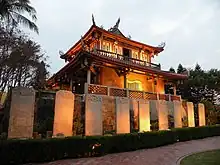
The courtyard at Fort Provintia in Tainan is lined with nine stone tortoises each carrying a 3-meter tall royal stele bestowed by the Qianlong Emperor to the general Fuk'anggan for suppressing the Lin Shuangwen rebellion. Inscriptions are carved in Chinese and Manchu
The Manchu people in Taiwan constitute a small minority of the population of Taiwan.
Migration history
The Manchu people living in Taiwan arrived primarily in two waves of migration. The first wave was during the Qing dynasty era, in which the Manchu-led government annexed Taiwan into the Qing Empire.[1] The second wave was immediately following the Chinese Civil War, when the Kuomintang retreated to Taiwan. As of 2009, there are about 12,000 Manchu people living in Taiwan.[2]
Notable people

Manchu writing at the Taiwan Confucian Temple. Inscription on the dismounting stele reads: "Civil and military officials, soldiers and citizens, all dismount from their horses here"
- Puru - artist and cousin of China's last emperor Puyi. He fled to Taiwan in 1949.
- Sihung Lung - actor in the Taiwanese cinema who appeared in over 100 films, best known for playing paternal roles in films including Eat Drink Man Woman and The Wedding Banquet.
- Chyi Chin - Taiwanese singer and songwriter.
- Chyi Yu - Taiwanese singer and songwriter.
- King Pu-tsung - Taiwanese politician currently serving as Secretary-General of the Kuomintang party.
- Doze Niu - Taiwanese film director, best known for the Taiwanese film Monga.
- John Kuan - current president of the Examination Yuan of the Republic of China.
- Bo Wenyue (鮑文樾) - one of the main participants in the Xi'an Incident and was held under arrest in Taiwan until 1975.
See also
- Jiu Manzhou Dang, a set of Manchu archives stored at the National Palace Museum in Taipei, Taiwan
References
- ↑ Stary, Giovanni (1995), On the tracks of Manchu culture, 1644-1994: 350 years after the conquest of Peking, Harrassowitz, pp. 77–82, ISBN 9783447036948
- ↑ 翁福祥 [Weng Fu-hsiang] (September 2009), 臺灣滿族的由來暨現況 [Origins and conditions of the Manchu ethnic group in Taiwan], 中國邊政, pp. 61–72, OCLC 4938167957, archived from the original on 2017-05-02, retrieved 2011-02-09
External links
- (in Chinese) Republic of China Manchu Society
- (in Chinese) Manchu Studies at National Chung Cheng University
- (in Chinese) Lapen Publishers (Manchu publisher in Taipei)
This article is issued from Wikipedia. The text is licensed under Creative Commons - Attribution - Sharealike. Additional terms may apply for the media files.